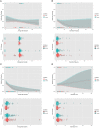Quantifying canine interactions with smart toys assesses suitability for service dog work
- PMID: 36118349
- PMCID: PMC9481248
- DOI: 10.3389/fvets.2022.886941
Quantifying canine interactions with smart toys assesses suitability for service dog work
Abstract
There are approximately a half million active service dogs in the United States, providing life-changing assistance and independence to people with a wide range of disabilities. The tremendous value of service dogs creates significant demand, which service dog providers struggle to meet. Breeding, raising, and training service dogs is an expensive, time-consuming endeavor which is exacerbated by expending resources on dogs who ultimately will prove to be unsuitable for service dog work because of temperament issues. Quantifying behavior and temperament through sensor-instrumented dog toys can provide a way to predict which dogs will be suitable for service dog work, allowing resources to be focused on the dogs likely to succeed. In a 2-year study, we tested dogs in advanced training at Canine Companions for Independence with instrumented toys, and we discovered that a measure of average bite duration is significantly correlated with a dog's placement success as a service dog [Adjusted OR = 0.12, Pr(>|z|) = 0.00666]. Applying instrumented toy interactions to current behavioral assessments could yield more accurate measures for predicting successful placement of service dogs while reducing the workload of the trainers.
Keywords: Canine Companions for Independence; animal behavior; computational behavior; instrumented toys; quantified interactions.
Copyright © 2022 Byrne, Starner and Jackson.
Conflict of interest statement
The authors declare that the research was conducted in the absence of any commercial or financial relationships that could be construed as a potential conflict of interest.
Figures






References
-
- Assistance Dogs International . Assist Dogs Int. (2022). Available online at: https://assistancedogsinternational.org/ (accessed June 24, 2022).
-
- Canine Companions for Independence (2017).
-
- Colman AM. “Temperament,” in A Dictionary of Psychology. Oxford: Oxford University Press; (2009). Available online at: https://www.oxfordreference.com/view/10.1093/acref/9780199534067.001.000... (accessed June 24, 2022). - DOI
LinkOut - more resources
Full Text Sources
Research Materials

